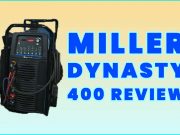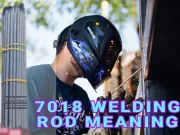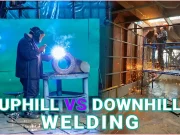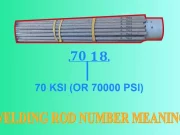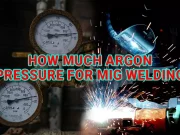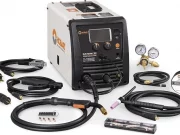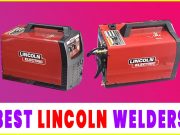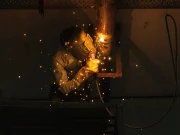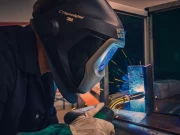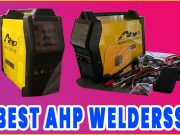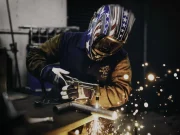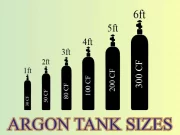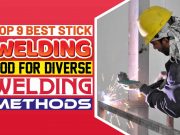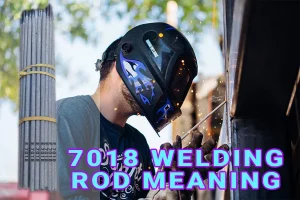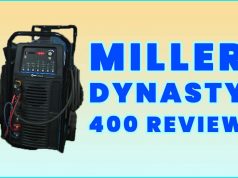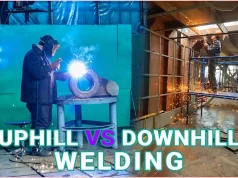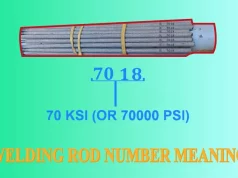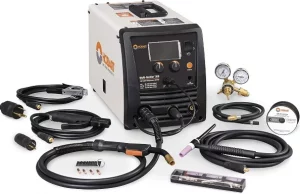Welding rods might seem like a tough choice for people who aren’t well-versed in welding matters, but they are crucial.
Some rods are common, and most people use them by default without giving it a thought, while others keep a keen eye on what they use to weld.
One of the most common choices for welding rods is the 7018 rods, and most people treat it as the standard for welding.
But what makes this rod stand out, and why should you use it? Let us take a close look into the topic to get the answers to these questions and more;
7018 Welding Rod
The 7018 electrodes are some of the most popular among welders, and we need to understand why this is the case.
We need to look at this rod to understand how it works and what makes it different from other rods. Let’s get into it;
The 7018 is a feel-freeze rod with a mineral-based flux. This heavy flux will grab hold of the weld, and you have to clean it off.
You can only drag the 7018 over a surface; you can’t use the whipping technique on it because of its flux.
The 7018 is a low hydrogen electrode, and it does not agree with atmospheric hydrogen; hence most people put them in a baking oven at about 2500 to keep the moisture out. This is because they lose effectiveness the more they sit out in the atmosphere.
For everyday work, the rods will work, but there is a time frame you have to adhere to when doing cold welds; too much exposure to the air might make the rods ineffective, so you have to re-bake them to get all the moisture out before using it.
The designation on the rod is 7018, which means that it produces a weld of 70,000 psi which makes it an amazing choice for heavy-duty welding.
It is an all-position rod; thus, you can use it flat, horizontal, overhead, and vertical, making it even easier to use.
The 7018 is very flexible in use, and that is part of why people love it so much; you can use weave beads and stringer beads with it. It is a very strong and good rod that will last much longer than other heavy-duty rods on the market.
Typically how it works is you run the root pass of the weld with a 6010 rod then use a 7018 rod to cover the rest of it. This rod does not penetrate as well as the 6010 rods; it fills up better than 6010.
The 7018 doesn’t go deep and narrow; it goes shallow and wide; thus, it is perfect to layer over the 6010.
It’s a thick, heavy flux, and you need to clean it very well; with 6010, the flux is flakier, and you can wire brush it off, but you need to try harder with the 7018.
The 7018 starts the same way as any electrode; you can use the pecking method to get it started or scratch-start it.
You won’t use any whip with the 7018 rods, drag it across the surface and go as fast as the puddle tells you to go.
Welders often use the 7018 in combination with the 6010, and these two are the most common electrodes.
You will inevitably use them both; most likely, you will use them together. They are different, and many of their characteristics are the same, while others are different.
How Does Welding Work?
Welding has been around more traditionally from the 4 AD, and modern welding techniques were the backbone of the industrial revolution.
These techniques are crucial to numerous industries, and it is an extensive field with hundreds of materials.
Even if you are not a welder professionally, understanding how certain materials join can be a useful life skill. Common welding processes include SMAW, TIG, FCAW, and SAW.
These are some basic methods, and there are more types, with each having variations and techniques that use friction, lasers, and electron beams.
The processes are specialized for different metals, and some can join metals with different properties like copper and iron.
Welding techniques initiate fusion using a powerful energy source; they melt base metals to get them to connect.
Processes like SMAW use an electrode that will generate heat, causing fusion of the base metals, and then fill the joint.
TIG welding combines tungsten and an inert gas to weld the base metal.
All the processes have an electrode or arch to spark the fusion between the metals. The only different type is resistance welding.
Resistance welding uses an electric current to heat through the electrical resistance of two metals overlapping each other. Arch welding is the most common type, but energy beam welding and gas welding are also available.
These methods use energy beams or gas to heat the metals instead of voltage and electrical currents.
These welding methods are rather easy to comprehend in mechanics; gas welding involves drawing gas from a welding tank and burning it to generate heat.
Arch techniques use a different electrode type with a different type of flux. Flux is a purifying agent that helps maintain a uniform structure and ensures the weld bonds with the metal; thus, the weld is stronger.
FCAW uses a wire with a flux core, while SAW uses an electrode to weld underneath a flux blanket.
The techniques differ and work best for specific metals, but TIG is the best option since it works for all metals.
The cell structure of a metal determines the method of welding that works for them. Melting points, phase changes, and many other factors affect how metals bond; thus, it is relatively easy to join similar metals.
To join different metals, for instance, aluminum and steel, you must get more innovative in your technique.
The standard way of doing this is using a filler metal close to both metals’ cell structures, so it works like a bridge.
7018 Welding Tips
If you choose one rod to use on something that you’d never move, the best rod to use would be a 7018. You will probably have to start with a 6010 then fill the cap with a 7018 to hold it strong.
The best part about 7018 is that it will bend, but it can’t break; therefore, you won’t be risking cracks in joints.
A 6010 rod is brittle, so it gives you deep penetration, and the 7018 will give you the additional power that can come out smooth and bend.
The best idea is to start with a 332; they are smaller and easier to use. Each time you are starting something or welding in a weird position, stick to smaller rods since they are more forgiving and easier to control.
If you are welding on the side of something, go over the space and hesitate at the end of the first round; let it burn at the end for a while before coming back.
This is important since it will help you figure out what happens, and you will see the rate of burning clearer as you fill it.
Using the right size of a welding rod is crucial, and if you use a larger rod than you need, there will be too much heat, and it will not look very good.
Additionally, the larger the rod, the more power it takes; therefore, constantly using large 7018s will take a toll on your welder.
Make sure you don’t outrun your puddle since your arch will start gorging and not filling, which will create an undercut and inconsistency with your weld. Something else you need to watch out for is extending the arch length.
Try to have a tight arch so you can’t see droplets coming from the electrode into your puddle. Once you extend it, it will become violently bright and uncontrolled; thus, it will damage the base metal and develop inconsistent sharp points on the backside.
Running a 7018 uphill as a beginner can be challenging, but if you give it some time and practice, you should be able to manage a fairly consistent weld.
Don’t use whipping techniques of any kind with the 7018; instead, pass it over the base metal at the correct speed to fill the base.
Conclusion
The 7018 welding rod is the most popular choice since it is easy to use and holds up much better than other rods. Most of the time, welders use a combination of 6010 rods and 7018 to take advantage of their best features and make a more reliable joint.
7018 bends, so it is a great option to use as filler as it eliminates the risk of cracks due to temperature changes. 7018 rods will give impressive strength and support; thus, they are a great option for something permanent.
You May Like These Articles As Well:

